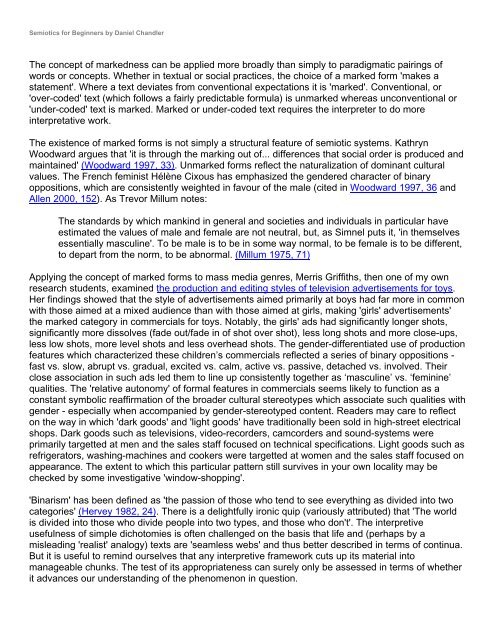Semiotics for Beginners by Daniel Chandler
Semiotics for Beginners by Daniel Chandler
Semiotics for Beginners by Daniel Chandler
You also want an ePaper? Increase the reach of your titles
YUMPU automatically turns print PDFs into web optimized ePapers that Google loves.
<strong>Semiotics</strong> <strong>for</strong> <strong>Beginners</strong> <strong>by</strong> <strong>Daniel</strong> <strong>Chandler</strong><br />
The concept of markedness can be applied more broadly than simply to paradigmatic pairings of<br />
words or concepts. Whether in textual or social practices, the choice of a marked <strong>for</strong>m 'makes a<br />
statement'. Where a text deviates from conventional expectations it is 'marked'. Conventional, or<br />
'over-coded' text (which follows a fairly predictable <strong>for</strong>mula) is unmarked whereas unconventional or<br />
'under-coded' text is marked. Marked or under-coded text requires the interpreter to do more<br />
interpretative work.<br />
The existence of marked <strong>for</strong>ms is not simply a structural feature of semiotic systems. Kathryn<br />
Woodward argues that 'it is through the marking out of... differences that social order is produced and<br />
maintained' (Woodward 1997, 33). Unmarked <strong>for</strong>ms reflect the naturalization of dominant cultural<br />
values. The French feminist Hélène Cixous has emphasized the gendered character of binary<br />
oppositions, which are consistently weighted in favour of the male (cited in Woodward 1997, 36 and<br />
Allen 2000, 152). As Trevor Millum notes:<br />
The standards <strong>by</strong> which mankind in general and societies and individuals in particular have<br />
estimated the values of male and female are not neutral, but, as Simnel puts it, 'in themselves<br />
essentially masculine'. To be male is to be in some way normal, to be female is to be different,<br />
to depart from the norm, to be abnormal. (Millum 1975, 71)<br />
Applying the concept of marked <strong>for</strong>ms to mass media genres, Merris Griffiths, then one of my own<br />
research students, examined the production and editing styles of television advertisements <strong>for</strong> toys.<br />
Her findings showed that the style of advertisements aimed primarily at boys had far more in common<br />
with those aimed at a mixed audience than with those aimed at girls, making 'girls' advertisements'<br />
the marked category in commercials <strong>for</strong> toys. Notably, the girls' ads had significantly longer shots,<br />
significantly more dissolves (fade out/fade in of shot over shot), less long shots and more close-ups,<br />
less low shots, more level shots and less overhead shots. The gender-differentiated use of production<br />
features which characterized these children’s commercials reflected a series of binary oppositions -<br />
fast vs. slow, abrupt vs. gradual, excited vs. calm, active vs. passive, detached vs. involved. Their<br />
close association in such ads led them to line up consistently together as ‘masculine’ vs. ‘feminine’<br />
qualities. The 'relative autonomy' of <strong>for</strong>mal features in commercials seems likely to function as a<br />
constant symbolic reaffirmation of the broader cultural stereotypes which associate such qualities with<br />
gender - especially when accompanied <strong>by</strong> gender-stereotyped content. Readers may care to reflect<br />
on the way in which 'dark goods' and 'light goods' have traditionally been sold in high-street electrical<br />
shops. Dark goods such as televisions, video-recorders, camcorders and sound-systems were<br />
primarily targetted at men and the sales staff focused on technical specifications. Light goods such as<br />
refrigerators, washing-machines and cookers were targetted at women and the sales staff focused on<br />
appearance. The extent to which this particular pattern still survives in your own locality may be<br />
checked <strong>by</strong> some investigative 'window-shopping'.<br />
'Binarism' has been defined as 'the passion of those who tend to see everything as divided into two<br />
categories' (Hervey 1982, 24). There is a delightfully ironic quip (variously attributed) that 'The world<br />
is divided into those who divide people into two types, and those who don't'. The interpretive<br />
usefulness of simple dichotomies is often challenged on the basis that life and (perhaps <strong>by</strong> a<br />
misleading 'realist' analogy) texts are 'seamless webs' and thus better described in terms of continua.<br />
But it is useful to remind ourselves that any interpretive framework cuts up its material into<br />
manageable chunks. The test of its appropriateness can surely only be assessed in terms of whether<br />
it advances our understanding of the phenomenon in question.




